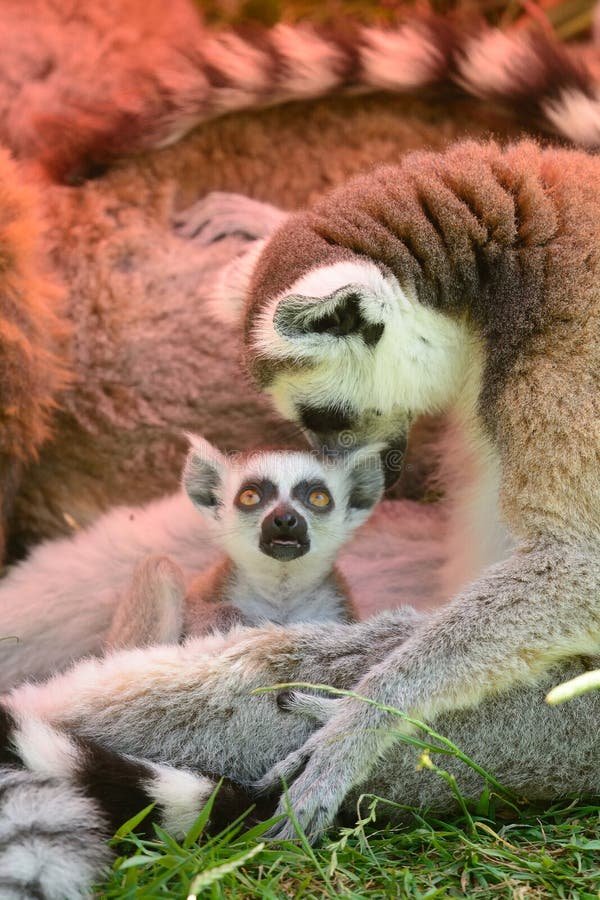
Let’s dive into the heart of how these lemurs nurture their offspring. Understanding their parenting style is not just interesting; it also gives us insight into the complexities of wildlife and the importance of community in raising young. By exploring the different aspects of their motherhood and family structure, we can appreciate the unique challenges and triumphs that ring-tailed lemurs face in their natural habitats.
The Lemur Family Structure
Ring-tailed lemurs live in social groups called troops, typically consisting of 10 to 30 individuals. Here’s the thing: these troops are mostly matriarchal, led by dominant females who have a significant say in troop dynamics, including mating and care of the young. A female lemur isn’t just a mother; she’s a leader.
Troops are comprised of related females and their offspring, while males may come and go. This family structure creates an environment where young lemurs are surrounded by not just their mothers but also aunts, sisters, and other female relatives. Each adult female plays a role in raising the young, from keeping them safe to teaching them vital survival skills.
You might be wondering about the role of males in this social structure. Male lemurs do help out occasionally, but their involvement in caring for the young is limited. This can be compared to a father figure who might not be the primary caretaker but still provides support and protection when necessary.
The Gestation Period and Birth
The journey of a ring-tailed lemur’s young begins with a gestation period of about 4.5 months. During this time, the expectant mother prepares for her new arrival in several ways. She’ll start to gather nesting materials, like leaves and twigs, to create a comfortable space for her baby.
When the time comes for birth, lemurs usually deliver one baby at a time, though twins are rare. In the wild, this usually happens between April and May, aligning with the season when food is more plentiful. After birth, the mother will immediately grasp her newborn with her teeth gently, and they’ll cling to her fur for security.
Initially, the baby is born with closed eyes and is helpless. But within a few days, they begin to open their eyes and explore their world. This highlights a crucial aspect of lemur parenting: the speed at which they grow and adapt in the wild—much faster than many other species.
Early Development and Bonding
Once the baby lemur is born, bonding is essential. In the first few weeks, the newborn clings to its mother, often riding on her back as she moves through the trees in search of food. This close contact is vital for survival. The mother always keeps her baby close, as young lemurs are vulnerable to predators like hawks and snakes.
As they grow, these babies become more curious and start to explore their surroundings. The mother will often let them venture out for short periods, but always within a safe distance. This nurturing approach teaches the young lemur about their environment, helping them learn how to navigate trees and find food.
Honestly, you can think of this as a game of “hide and seek” where the young ones are learning the rules of survival. They get to test their skills while still having their mom close by to protect and guide them through the initial dangers of life.
Learning Through Play
Play is a critical part of a young lemur’s development. You might not expect it, but this playful behavior is akin to kids on a playground, testing their physical limits and social skills. Young lemurs engage in chasing, wrestling, and even mock fights. This isn’t just for fun; it helps them develop strength, agility, and social bonds.
During playtime, young lemurs often interact with their peers, learning important skills for their future. They figure out how to establish dominance and work through conflicts—all crucial lessons for adult life. This playful behavior helps them understand their position within the troop’s social structure, which is vital for their future interactions with others.
Interestingly, mothers often watch closely during these play sessions, occasionally stepping in to reinforce behaviors or break up tussles. It’s a way for them to teach while still allowing independence, striking a balance between guidance and freedom.
Motherhood Challenges
Raising young lemurs isn’t without its challenges. One major issue is the availability of food. During the dry season, food sources can become scarce, which makes it more difficult for mothers to provide enough nutrition for themselves and their babies. This often leads to a situation where the health and survival of the young depend heavily on the mother’s ability to find food.
Additionally, predators pose a constant threat. Young lemurs are particularly vulnerable, and mothers must be vigilant to protect them. They often use their strong sense of smell and sharp eyesight to detect danger and alert the troop. Honestly, it’s a tough job—similar to being a single parent trying to juggle work and family while keeping everyone safe.
Through these challenges, the resilience of lemur mothers shines through. They learn to adapt, often changing their foraging habits or moving their troop to safer areas when needed. Their dedication to overcoming obstacles ensures that more young lemurs successfully reach adulthood.
The Role of the Troop in Raising Young
In the world of ring-tailed lemurs, parenting isn’t a solitary endeavor. The entire troop plays a part in nurturing the young. Older siblings, cousins, and other troop members often pitch in by babysitting or keeping an eye on the little ones while their mothers forage.
This communal care offers significant advantages. It allows mothers to take breaks and ensures that youngsters are constantly supervised and socialized. Young lemurs learn behaviors not just from their mothers but also from observing others in the troop. They can pick up on social cues and grooming habits, which are critical for their development.
Consider this approach like a team of coaches for a young athlete. Each adult lemur has knowledge and skills to share, enriching the learning experience for the young ones. In the end, this collective effort helps strengthen troop bonds, making them more effective as a community.
Growing Up and Independence
As babies grow, they gradually gain independence. By around six months, young lemurs start exploring further away from their mothers. They begin to practice skills like climbing and foraging on their own. This period is crucial as they start to form their identities and learn to adapt to life in the wild.
Mothers might still call for their young, maintaining a close emotional connection. But there’s a clear push towards independence, much like when a teenager is learning to drive for the first time. They need room to make mistakes and learn about the world.
By the time they’re about a year old, young lemurs are nearly ready to fend for themselves. They will have learned essential skills, from finding food to navigating their social structure, preparing them for life as fully-fledged members of their troop.
As they reach maturity, they’ll begin to participate in the troop’s daily activities, ultimately contributing to raising the next generation of lemurs. It’s a beautiful cycle that ensures the survival of their species.
In closing, the way ring-tailed lemurs raise their young in the wild is nothing short of remarkable. From their social structures to the challenges they face, each element plays a critical role in nurturing the next generation. This unique community approach offers vital lessons about cooperation, resilience, and the importance of family bonds in the animal kingdom. Next time you think of these playful creatures, remember the intricate web of care and support that helps them thrive in their natural habitat.

